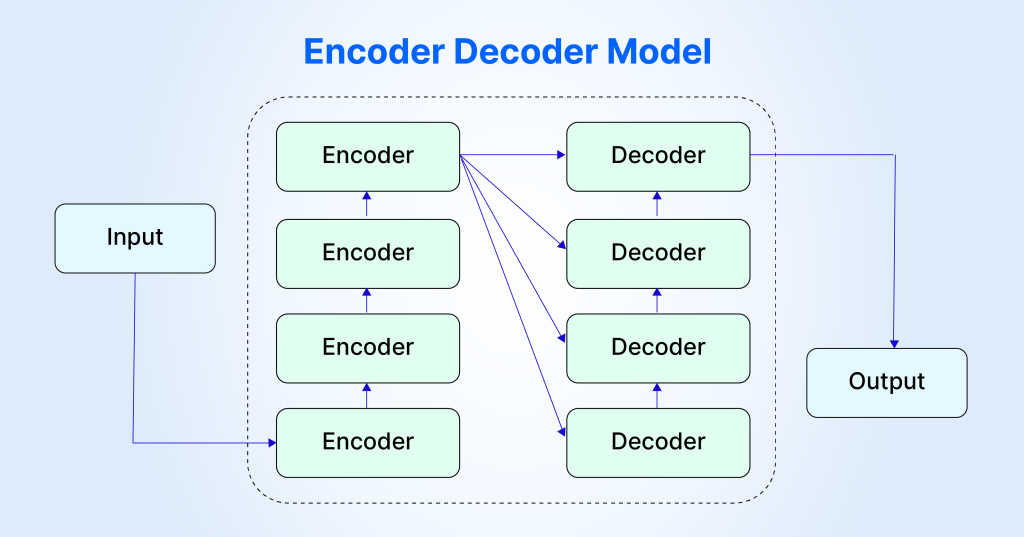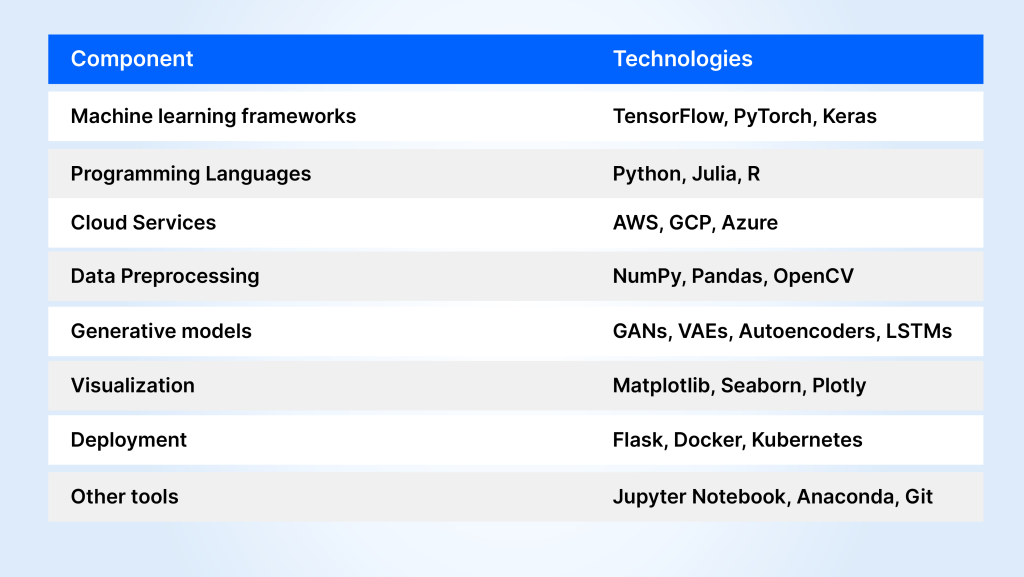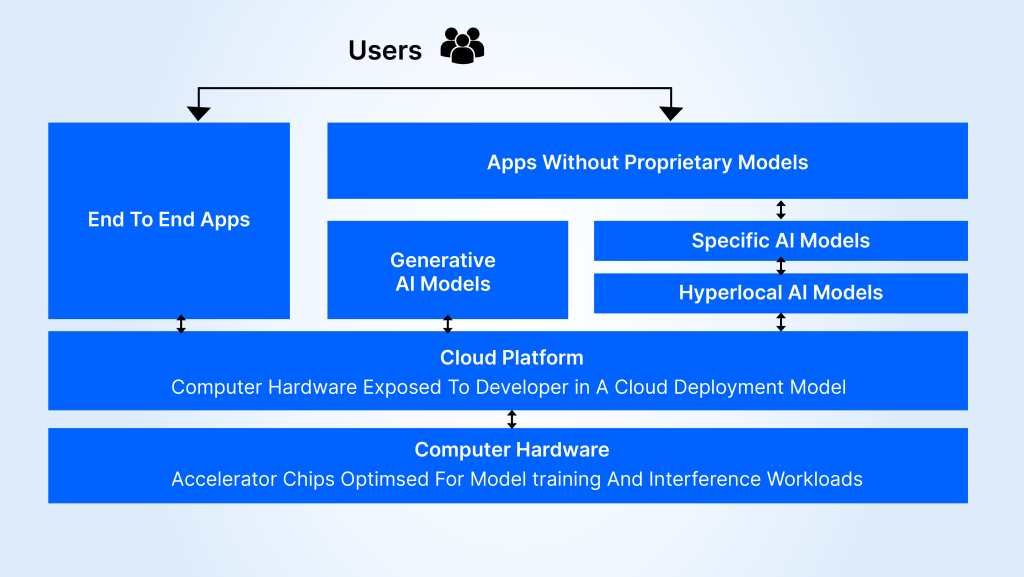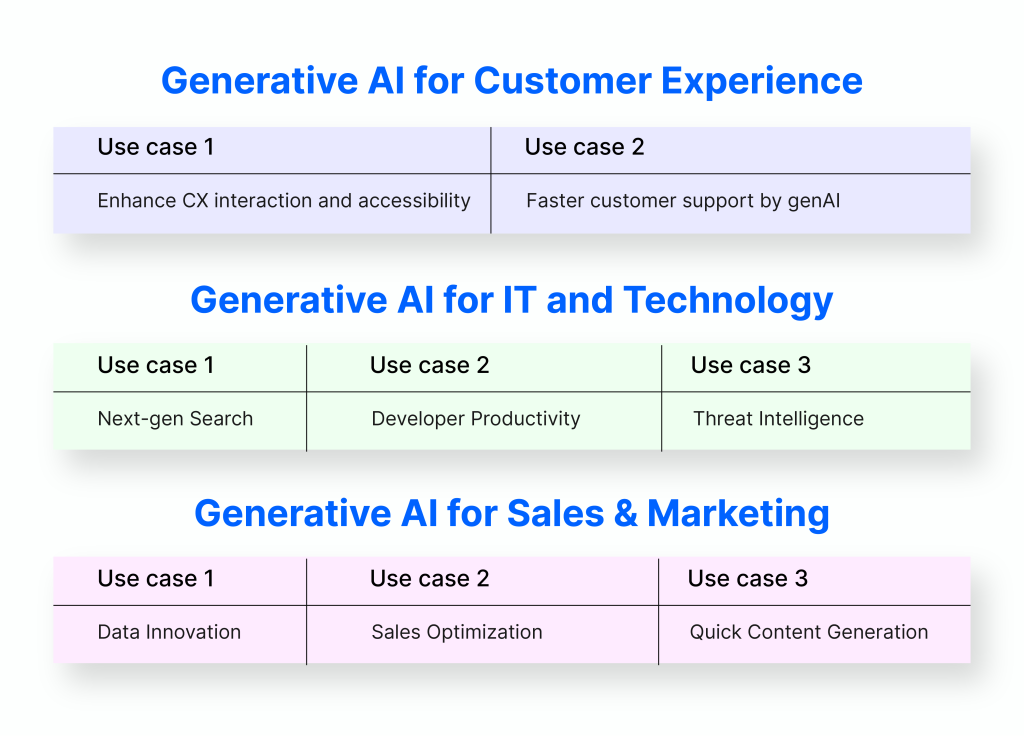When teams operate independently, it creates communication gaps that can lead to disorder. In contrast, when teams collaborate, they tend to be more efficient.
“A set of technologies and techniques using vast datasets and large language models for pattern recognition and prediction to generate new content, including texts, images, sounds, and code. “Enterprises can get a strategic advantage today by leveraging AI that was previously unattainable and become highly competitive in the market.”
AI has been around for a long time, but the launch of ChatGPT in November 2022 made companies rethink their workflows and processes. It gained a user base of over a million in just five days and grabbed global attention. According to the Financial Times, Investments in generative AI exceeded $2 billion in 2022, with OpenAI’s potential sale price set at $29 billion. Today, AI shows no signs of slowing down. With over 180.5 million users, ChatGPT has become a pioneering force and one of the world’s most valuable private companies. This generated significant interest in AI technology from companies and investors. Businesses started using artificial intelligence to improve, elevate, enable, and engage their employees and customers. The prominence of Generative AI is seen by the biggest investment ever made by Amazon, $2.75 billion in April 2024 to buy the AI startup Anthropic, which exemplifies the growing importance of Generative AI.
This demonstrates AI isn’t slowing down anytime soon! It’s time to explore Generative AI (GenAI) and see what the GenAI Tech Stack can do for businesses.
The term Generative AI refers to the type of artificial intelligence employing statistical algorithms that help in creating new content like images, text and code. It uses supervised and unsupervised learning algorithms to process large amounts of data, as well as large language models to understand text and generate new content. However, the data you provide to AI influences the results or output. Gen AI has limited parameters and requires human collaboration. Despite the collaboration, Generative AI still faces challenges such as accuracy, bias, and unexpected outputs.
On the other hand, generative AI tech stack refers to a set of technologies and tools that involves autonomously creating content, such as images, text, or code known as generative modelling which depends on predictive algorithms to understand patterns and relationships within a dataset. Generative Artificial Intelligence has transformative capabilities that help enterprises and businesses to reform their business processes.
GenAI models include multiple models like GANs and VAEs representing the front end of AI innovation. Each model has its unique capabilities. Let’s explore the types of generative AI models:

GANs are like AI systems with two neural networks: The generator and the discriminator. They both function in the same room but dance against each other.
Generator | Discriminator |
|---|---|
The role of the generator is to create synthetic data like images, text, code or anything that replicates real-world data. | The discriminator functions to scrutinize the data generated by the generator and distinguishes it from the generated data. |
As they both work adversarial, they improve over time. The generator model creates more convincing content while the discriminator can detect fakes better. The fusion play results in producing content that is nearly identical to real-world data.
For instance, they can generate images lifelike for objects, images and places. GANs can be applicable in many industries like art. It already has applications in art generation in which GANs can generate art that is virtually indistinguishable from the art of paintings that are made by humans.

Transformers play a great role in the GenAI landscape. They are famous for their ability to handle data in sequence rather than tackling data individually like texts and speech when transforming input to output. They are impressive at producing results. Unlike GANs, they work on one neural network. They are highly adaptable because of architectural scalability and flexibility. They can capture relationships between sequential data which makes them versatile. Transformers are valuable in machine translation, creating text summaries, Q&A’s, quizzes and other text-related tasks.
Transformers embrace an encoder/decoder architecture as a dual-pronged approach. This approach fuels their remarkable capabilities. The encoder works by extracting key components from the input text and smoothly sending it through a series of encoder blocks. The output of the final block acts as a decoder’s basic input.
On the other hand, decoder blocks come into play as collaboration. Each block gets ready to get the encoded features by the encoder. This collaboration results in the output sentence that is similar to translation but beyond linguistic borders.
Transformers illustrate the merging of context, sequence, and comprehension in generative AI. This allows natural language requests to be transformed into physical commands, whether images or text, driven by the minute details of user descriptions.
VAEs consist of two interconnected networks, an encoder and a decoder. The encoder converts input data to a reduced simplified format known as latent space or latent representation. Then it takes a unique approach to generate new data similar to the original but not identical.
For instance, if you train it to generate human faces it learns the important features of faces from pictures and generates new faces. The output face will have unique attributes. The applications of VAEs are versatile like data generation, feature extraction, compressing data and more. They are capable of creating more concise versions yet expressive formats.
This model is unique in its capabilities as it can understand and process multiple types of data at once ranging from texts to audio. They can create more outputs by integrating information in different modalities like creating a text description for an image this is called cross-modal functionality. There are alot of real-world applications like DALL-E and GPT-4.

GenAI has gained attention quickly in almost every industry. We have a comprehensive generative AI stack, simplifying the development process. Let’s check the core components:
Application frameworks are the base of AI stacking. It provides an organized programming model that helps with the quick integration of the latest technologies. AI agents can build applications to perform tasks using frameworks like LangChain, Fixie and Google Cloud Vertex AI. These applications can generate content on their own and build semantic search systems to help AI agents.
At the heart of the Generative AI stack, lies foundation models (FMs) also referred to as the “system brain” for example, OpenAI, Anthropic and Cohere. These models can be open-source or proprietary and can enable human-like conversation. It is upon developers that how they train their model to optimize applications by employing multiple FMs. Developers host these models on servers and deploy them on edge devices and browsers which provide security and optimizes cost.
The ability of Language Learning Models (LLMs) to reason the data they have been trained on is essential. Developers operationalize their data to improve the accuracy of these models. By enabling the efficient storage and retrieval of data vectors and the ingestion of both structured and unstructured data, data loaders and vector databases play essential roles. Retrieval-augmented generation is one technique used to customize model outputs.
The ideal balance between latency, cost, and model performance can be difficult when doing AI stack. For this developers use a variety of assessment tools that track online and offline experimentation, help identify the most effective prompts, and provide real-time model performance monitoring. This includes tools like WhyLabs’ LangKit, prompt engineering, No Code / Low Code tooling, and tracking tools used for rapid engineering, experimentation, and observability.
In this phase, developers move their final applications into production procedure. Either they can self-host or use third-party services for deployment. They can use tools like Fixie.ai for seamless development and deployment of AI applications.
A tech stack has a set of technologies, frameworks, models and tools that are used to develop and deploy applications. A great tech stack has listed all of these and it is effective while building generative applications. It includes various components like ML frameworks, programming languages, infrastructure of the cloud and tools to process data. Let’s discuss all these one by one:
Generative AI systems use sophisticated machine learning models to generate new data. For generative AI use cases, some frameworks can be used such as TensorFlow, PyTorch, and Keras. Using these frameworks, you will get a variety of pre-built models for generating text, images, and music in addition to tools and APIs for building and training models. These frameworks offer flexibility by allowing models to be designed and customized to the required degree of quality and accuracy which is why they are essential to be in any generative AI stack.
Programming languages can balance the ease of use and performance of generative AI models. The most used language is Python as it is simple, readable and supports extensive libraries. OpenAI tech stack also has Python at its core.
GenAI systems use large amounts of computing power and storage to train and run the models. Cloud generative ai infrastructure when utilized in the tech stack of generative AI applications provides the scalability and flexibility that are needed to deploy GenAI systems. Real-world examples include AWS generative AI, Google Cloud Platform, and Microsoft Azure offer a range of services like virtual machines, storage and ML platforms.
Data is the main spice when cooking generative AI systems. But, the data must be preprocessed, cleaned and transformed before it can train the models. Apache Hadoop is commonly used to handle large datasets, Apache Spark can provide data visualization and exploration capabilities. These tools can help understand data and identify patterns in it for better output. That is why a well-stacked technology can improve overall system accuracy, scalability, and reliability and provide faster deployment.

Let’s examine each layer in detail:

The application layer in the generative AI tech stack enables collaboration between humans and machines, serving as essential workflow tools for businesses and entertainment. It enables the generation of innovative outcomes, boosting productivity and fostering entertainment. This layer can be categorized into two types.
End-to-end apps using proprietary generative AI models are gaining popularity, incorporating AI models into user-facing products. These models are developed by companies with domain-specific expertise, typically protected by intellectual property rights. They are made available to customers as part of a software product or service. Generative AI Examples include OpenAI’s DALL-E, Codex, and ChatGPT. These apps have a broad range of applications, from text generation to automated customer service and personalized recommendations. As generative AI evolves, more innovative end-to-end apps using proprietary models are expected.
These are commonly used in B2B and B2C applications. These apps use open-source frameworks or libraries like TensorFlow, PyTorch, or Keras to build custom models for specific generative AI use cases. Examples include RunwayML, StyleGAN, and NeuralStyler. These apps provide a wide range of resources and support communities, allowing for highly customizable outputs. Open-source frameworks democratize AI technology, fostering innovation and creativity.
The above was the application layer which is based on AI models. The unique combination of these layers allows for maximum flexibility for your market needs. The three layers of AI engines below offer the basis for producing amazing generative tech outputs, regardless of whether you need a wide range of features or extremely focused specialization.
General AI models are versatile. Common examples include GPT-3, DALL-E-2, Whisper, and Stable Diffusion. These generative AI examples can mimic human-like thinking and adaptability, in contrast to narrow AI models made for particular tasks. Text, graphics, voice, and game outputs are just a few of the many outputs they can manage. These models are open-source and user-friendly. Generative AI in healthcare can analyze large amounts of patient data to provide accurate diagnoses and treatment recommendations. General AI models have the potential to improve productivity. AI can automate business processes and tasks across industries, and make better predictions.
Customized AI frameworks or domain-specific models are known for their task excellence. They perform with more precision and nuance than general AI models. For instance, generative AI models that have been trained on e-commerce product photos are aware of the subtleties of good product photography, taking into account elements like lighting, composition, and product placement. Moreover, this generative AI can be useful for writing lyrics for songs that are customized to particular artists or genres, expressing the stylistic variance of each. These specialized models enable companies in e-commerce and the creative arts to produce customized, superior products.
Hyperlocal AI Models are the pinnacle of generative technology. They use exclusive and specialized datasets to produce outputs with unmatched precision and provide customized outputs with accuracy. For instance, they can be used in interior design, copywriting for marketing purposes and code generation. They can completely change industries by increasing productivity, profitability, and efficiency. They help with automating repetitive tasks, generate creative content, and deliver targeted solutions to specific customer bases. Hyperlocal AI models represent the future of customization and specialization in AI.
This layer is often hidden from view but is at the heart of foundational support for generative AI scalability and precision including components like:
Hardware components are specialized processors, such as GPUs (Graphics Processing Units) and TPUs (Tensor Processing Units), that handle the complex computations required for AI training and inference. Storage systems also play an important role in managing and retrieving large datasets used in AI. However, these processors greatly accelerate data processing and model training, leading to faster experimentation and more efficient use of resources.
Software components provide developers with the tools to train and optimize the AI models. TensorFlow and PyTorch are examples of these frameworks that provide libraries and pre-built modules, simplifying the development process. There are critical components for streamlining AI workflows beyond frameworks like data management tools, data visualization tools, optimization tools, and deployment tools. They ensure that data is properly prepared and cleaned, monitor training and inference, and allow trained models to be deployed in production environments.
Cloud providers provide organizations with instant access to huge storage capacity and computing resources. These services eliminate the need for organizations to manage and maintain physical infrastructure manually as computing resources are scalable and cost-effective. As a result, organizations can efficiently scale the capabilities of the Generative AI Tech Stack.

While creating a Generative AI tech stack, consider the project’s size and purpose. The importance of your project will be identified by the type of tech stack you choose, it could be simple or complex and extensive. For medium and large-scale projects developers use complex generative AI technology stacks utilizing multiple levels of programming languages and frameworks to ensure integrity and performance. Here’s what matters most:
The type of data is important like you want to generate (images, text, music) dictates the generative AI technique (GANs for images, RNNs for text/music). The project complexity is important with numerous variables, layers, or large datasets that might necessitate powerful hardware (GPUs) and advanced frameworks (TensorFlow, PyTorch). Moreover, If you need high volume generation or extensive user support, consider cloud-based solutions like AWS, Google Cloud Platform, or Azure for scalability. For applications like drug discovery or autonomous driving, where precise results are crucial, prioritize techniques known for high accuracy (VAEs, RNNs). However, Real-time applications like video generation or chatbots require a focus on speed. Lightweight models or code optimization should be prioritized within the tech stack.
Acquire deep technical knowledge to excel in choosing the right technologies. The more technical knowledge, the more you will become confident and wise while choosing the technologies for your tech stack that you are proficient with. The decision should not hinder developers’ progress or force them to spend time learning new technologies. This includes:
You need to leverage existing team knowledge in specific programming languages or frameworks to accelerate development. It is important to access powerful hardware (like GPUs) that opens doors to advanced frameworks like TensorFlow or PyTorch. Try to prioritize tech stacks with robust support communities and readily available training resources. Then, choose a cost-effective tech stack that delivers on project requirements without exceeding budget limitations. Lastly, consider the long-term maintenance and ongoing support needed when selecting the technology stack.
If your project aims to generate a large number of variations or serve a substantial user base, pay attention to scalability. Choose a scalable generative AI tech stack including cloud-based solutions, like:
These solutions offer elasticity and can seamlessly scale to meet growing demands. They can auto-scale and distribute workloads across multiple servers, ensuring your system remains responsive even under heavy loads.
Moreover, you can Implement Kubernetes or Docker for containerization and orchestration, making it easier to scale components of your system.
Security is a main concern for every user. Select high-security technologies when you form tech stacks, particularly for online payments. Here is how the need for security impacts the choice of technologies:
A tech stack with built-in security features should have encryption, access controls, and data masking, especially when dealing with sensitive datasets. Safeguard valuable intellectual property by choosing a tech stack with features that prevent unauthorized access to your generative AI models. Moreover, fortifying the system’s infrastructure against unauthorized access or attacks is important. Your tech stack should have firewalls, intrusion detection systems, and monitoring tools. Ensure legal and regulatory adherence (HIPAA, PCI-DSS) with built-in compliance features, especially in sensitive sectors like healthcare or finance. Lastly, implement user authentication and authorization that restrict access only to authorized users.
Generative AI is no longer a will-be decision; it’s a strategic priority now to thrive. However, integrating it into a business process may seem difficult after seeing the complexity and the broad range of technologies and frameworks. However, generative AI for businesses should begin by identifying areas within their current operations to bring improvements with generative AI use cases. However, you can start by focusing on generative AI practical applications:

IntellicoWorks has its finger on the pulse of generative AI trends. We offer AI development services with in-depth analysis and tailored solutions to integrate these advanced tools and frameworks effectively into your business operations for better productivity. Our team possesses the best knowledge and practices in AI disciplines including ML, NLP and AI chatbots.
Our toolkit incorporates the most recent developments in the rapidly developing field of artificial intelligence along with well-established frameworks including; including TensorFlow, Keras, PyTorch, Fast.ai, Pandas, and XGBoost, to ensure efficient and seamless development of complex AI applications. IntellicoWorks believes that the evolving generative AI landscape will ultimately help businesses generate new revenue streams, extensions, and channels to achieve profound growth and reinvent themselves, forcing entire industries to restructure around the value generated by machines.
In summary, organizations that fail to embrace generative AI risk falling behind. Investing in the right tools and infrastructure is essential for the successful development and deployment of generative AI models. A generative AI stack of technologies is a must for organizations that are integrating AI into operations. It has numerous benefits ranging from unlocking the full potential of AI models to automating routine tasks and creating customized outputs. However, a well-implemented tech stack can streamline workflows, reduce costs, and improve efficiency. Using specialized processors, storage systems, and cloud computing services, organizations can develop, train, and deploy AI models at scale. Open-source generative AI frameworks like TensorFlow, PyTorch, or Keras allow developers to build custom models for specific use cases. IntellicoWorks aims to help your business optimize operations and unlock the transformative potential of GenAI no matter what use case you have.
Revolutionize Your Business with AI Development Solutions!

Talk to us and let’s build something great together
A Subsidiary of Vaival Technologies, LLC
IntelliCoworks is a leading DevOps, SecOps and DataOps service provider and specializes in delivering tailored solutions using the latest technologies to serve various industries. Our DevOps engineers help companies with the endless process of securing both data and operations.
Ops
Cloud
AI & ML
Copyrights © 2023 byIntellicoworks. All rights reserved.